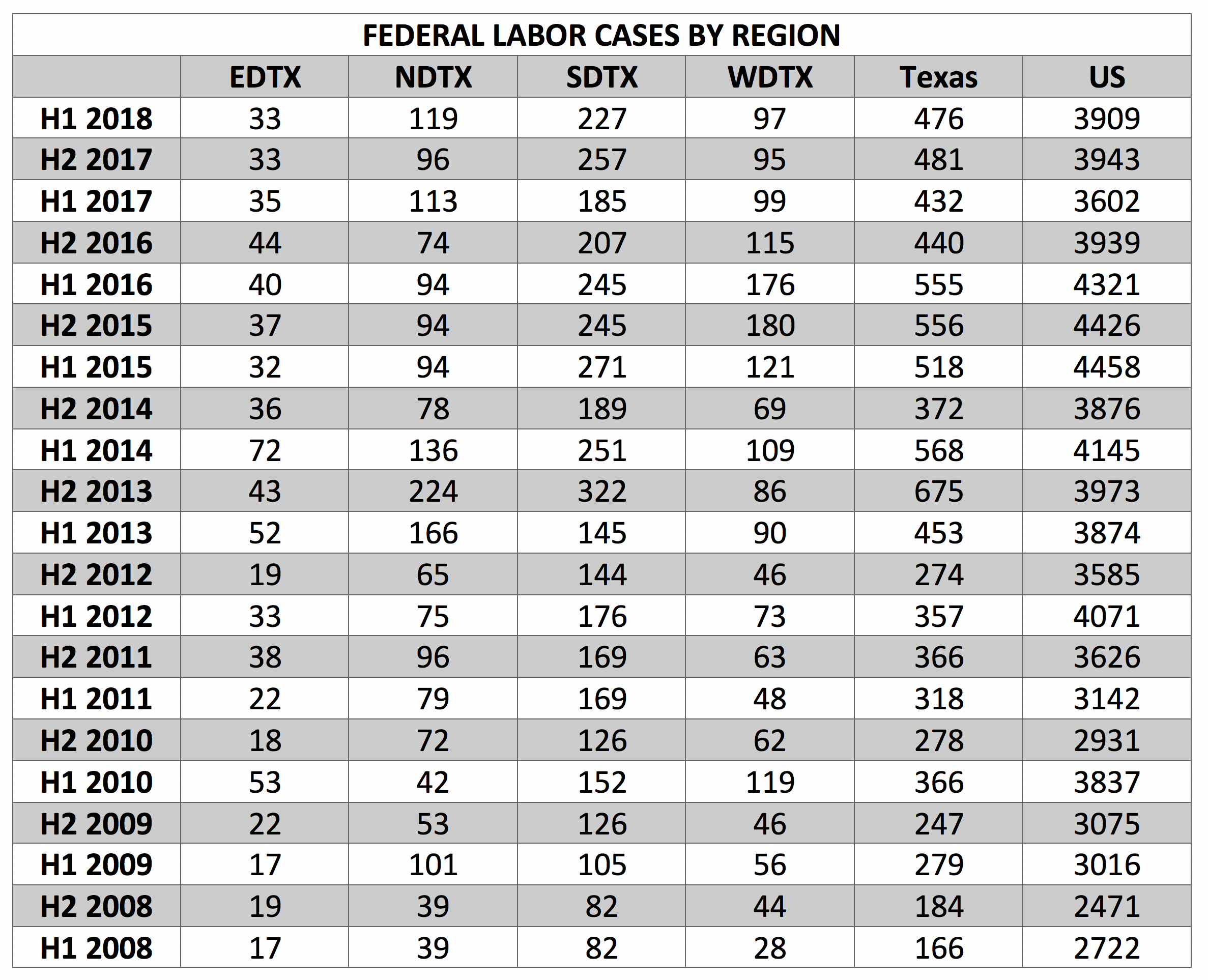What do you get when you combine an innovative and aggressive plaintiff’s bar with sloppy business practices, corner-cutting by contractors and failure to properly compensate day laborers?
A thriving labor and employment law practice in the Lone Star state.
Wage and hour litigation in Texas – and especially in Houston – has been in hyperdrive for the past six years and shows no sign of slowing down anytime soon. That is great news for law firms that defend corporate clients.
Federal courts in Texas saw 476 new lawsuits filed under the Fair Labor Standards Act during the first six months of 2018, according to new data from Androvett Legal Media and provided exclusively to The Texas Lawbook.
The 476 new wage and hour complaints is 10 percent more than were filed during the first half of 2018, up 50 percent from 2012 and are nearly triple the number of such cases a decade ago.
The Androvett statistics show that more than 900 new FLSA lawsuits have been lodged in Texas each year for the past six years – up from 350 in 2008.

“It doesn’t look like there’s any slowing down for a while,” said Rachel Powitzky Steely, a partner in Foley Gardere’s Houston office who serves as vice chair of the firm’s labor and employment practice.
The U.S. District Court in the Southern District of Texas, which includes Houston and Galveston, is the FLSA litigation capital of the U.S.

There were 227 wage and hour lawsuits filed in the Southern District during the first half of 2018, according to the Androvett data – a 23 percent increase from the same time period in 2017 and nearly double the 119 FLSA cases brought during the first six months of 2018 in the Northern District of Texas, which includes Dallas and Fort Worth.
The Western District of Texas, which runs from Austin to El Paso, has also been a hotbed for wage and hour litigation. The Androvett data shows that 97 FLSA cases were filed in the WDTX during the first six months of 2018, which is more than triple the number of such lawsuits lodged during the first half of 2008.
The Western and Southern districts have one common denominator: oil and gas.
For example, hundreds of lawsuits have been filed in those jurisdictions during the past few years in cases where oil and gas project leaders instructed workers and truck drivers to arrive at the worksite at specific times but then do not put them to work until a couple hours later. Some businesses declined to pay employees for the time between their arrival and when they started working. Judges have uniformly ruled this practice is a clear FLSA violation and such cases have become slam dunk wins for plaintiff’s lawyers.
FLSA litigation spiked and hit record highs in 2015 when commodity prices plummeted and energy companies conducted mass layoffs in the oil patch.
Wage and hour lawsuits have declined as the price of oil and gas has improved and exploration and production companies have gotten busier – especially in the Permian Basin.
“The Permian is the hottest place in the country – if not the world – right now,” Steely said. “I have seen cases [there] that have started and stopped in which… plaintiffs just drop the case. They don’t want to pursue it anymore or are not interested in fighting it because they know the market’s hot right now and they can make a pretty good wage and not have to mess with [a wage and hour lawsuit] and have it hanging over their head.”

Due to the current FLSA environment, Winstead labor and employment shareholder John Linker said it is critical that human resources departments remain proactive and “continue to do their due diligence and conduct internal audits” to make sure they are “maintaining the appropriate and lawful pay practices” and that “people are properly classified as exempt and not exempt.
“Now’s the time to address changes if they need to be made, or at least get a realistic assessment of your potential exposure before [a lawsuit’s filed] and make a strategic decision based on that … you don’t want to wait until you get served with a lawsuit,” Linker said.
Corporate labor and employment experts say FLSA is antiquated, complex and written in a way that makes it easy for employers to violate – even if they don’t mean to.
“Although an employer may not be intentionally trying to be noncompliant with FLSA, the reality is there are very technical, almost antiquated laws that haven’t changed over the course of decades, so if you have one violation you have numerous violations,” Linker said.
Mark Shoffner, a labor and employment partner at Bell Nunnally & Martin, concurred.

“Even in the face of a good economy, these lawsuits will continue to be filed because perfect compliance with the wage and hour laws is difficult for employers, and it is easy to make a minor mistake that has major consequences,” he said.
Shoffner added that these kinds of cases can get extremely expensive for companies to defend, especially due to the amount of attorneys’ fees plaintiffs’ lawyers have the potential to recover on if they prevail.
“Plaintiffs’ lawyers are entrepreneurial and filing these cases in volume has proven to be a sustainable business model,” said Shoffner, who represents companies in employment disputes.
Shoffner said the implementation of tort reform in the early 2000s and, more recently, the TC Heartland Supreme Court case – which changed the guidelines for venue determination in intellectual property cases – are likely two major factors that have caused plaintiff’s lawyers to flock toward FLSA cases.
Another Supreme Court decision that came down earlier this year, NLRB v. Murphy Oil, is also likely to contribute to future increases in FLSA litigation, lawyers say. In the case, the nation’s high court ruled arbitration agreements that include class action waivers are lawful.
“You see a lot of cases being filed but they may be broken up… into additional filings or additional arbitrations,” Steely said. “It will be interesting to see the effect of that.”
Steely said that since the Supreme Court decision did not occur until well into the first half of 2018, “it will be interesting to see what happens with the next half.
“I don’t really think it will come into play until 2019 and 2020,” she said.
